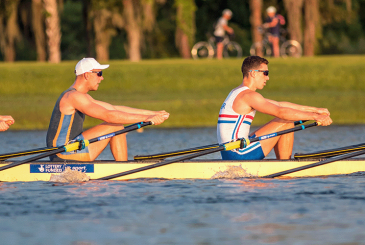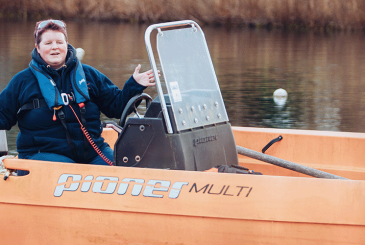Learn to row courses can really help your club and rowing community to thrive. How do you maximise this opportunity? Rowers at Durham ARC, Peterborough and Thames Tradesmen share their insights
Rowing clubs would, quite simply, be nothing without their members: they rely on a strong membership base to grow and to support their aims, both practically and financially. Learn to row courses are a perfect opportunity to bring new people into the sport, opening up access, setting strong foundations and promoting club spirit.
Pete Brewer, who manages the learn to row programme at Thames Tradesmen, says: “It brings a club together: tea and biscuits afterwards is as important as shiny boats. Members learn from volunteers, so from day one they’re part of the club. Community is everything.”
Durham Amateur Rowing Club has been running learn to row courses for more than a decade and the courses, now overseen by community coach Tim Morris, are very much part of the club structure.
Tim says: “Most people will make contact with the club, they’ll probably come down and meet the captain and then they’ll end up with me on a learn to row course, be that adult or junior. I will then stay with them right through until they ultimately join one of the other groups – it’s a long-term thing.”
Courses can be promoted on club websites, on social media and in the local press, but the main driver for recruitment tends to be word of mouth and recommendations from former participants, so it is critical that clubs think very carefully about what they can commit to delivering, respecting the fact that participants are effectively paying customers and managing expectations accordingly.
“You need to have a really well-structured coaching staff if you are going to do it properly”
Tim says: “People have shown an interest in the product you have got for sale, so you have got to make sure that the product is the right quality, that it’s value for money and that you give it your best shot to make it the best experience that you can.
“And if you are second rate in any of these elements people are going to walk away at the end of it and that’s not the objective. The objective is to increase membership.”

There is no one-size-fits-all: many learn to row courses run for a set number of sessions over a couple of months; other clubs prefer a focused weekend.
At Durham, courses run over six weeks for groups of five. Tim says: “The thinking behind that is that it’s not intensive, the participants are not committing all of their day to the course, but – slightly more importantly, and a bit more nuanced – we’re trying to create the habit of coming down to the club every weekend.
“You want to expose each individual to as much of the club as frequently as you can, so they get comfortable in the environment.”
He adds: “Everyone has to view their own circumstances and understand what their resources can physically handle. You’ve got to have in place the format and framework with which you are going to work: that’s people, access, boats, equipment – all of those things need to be clearly defined before you start to look for participants.”
“Courses are also a perfect ‘learn to coach’ opportunity”
At Peterborough City, learn to row capitalises on their purpose-built 1k rowing lake and a large fleet by focusing on single sculling.
Co-ordinator Peter Forrest – who himself started out on a learn to row course at the club and went on to win Club Development Coach of the Year at the 2020 British Rowing Awards – says: “It’s a great environment to conduct a course. Everyone feels pretty safe. The coaches are within a small distance, so you’re ideally placed if anything goes wrong, but you can also communicate really easily.
“We’ve decided that a single scull is going to be the fastest way for you to learn, primarily because there’s only you in the boat and any mistakes are down to you. You get instant feedback, both from the good and the bad.”
New recruits are put out in playboats with floats: “They’re very, very stable, and you can just get out there and enjoy the water without the fear of capsizing. And then, slowly but surely, we lower the stabilisers, take them off, and then they start to row without them, so they feel the balance of the boat.”
Single sculling literally allows participants to learn at their own pace, and Tradesmen are also starting to develop a tailored approach via off-water e-learning.
Pete Brewer says: “If I were a doctor and gave 20 patients the same prescription, they wouldn’t get better. The same with rowing. Everyone learns differently.
“By creating e-learning – workouts, how-to videos and rowing literature – you can help people learn the skill sets using different approaches.”
“Tim regards the time between the end of the learn to row course and joining a squad as absolutely vital”
Once the framework has been set up, it’s critical to establish a strong coaching team to deliver the course. Tim says: “They’ve to be able to coach beginners. It has to be the right person for the job, who can convert the jargon into something people can understand.”
Peter agrees: “The human body knows how to hop, skip and jump, but actually to sit down and row is not a natural thing to do. You need to have a really well-structured coaching staff if you are going to do it properly.
“We are very fortunate because we’ve got a team of coaches who are fully British Rowing qualified and, most importantly, they understand how to get the rapport between coach and athlete.”
He adds that the courses are also a perfect ‘learn to coach’ opportunity.
“You can grow your coaching staff as well. People are a lot less intimidated when they’re coaching learn to row; they get involved and really enjoy doing that.
“I try to bring on anyone who’s interested: we can train them up, we can grow and build them, which then builds the athletes, which builds the club and we get a nice positive spiral.
“In fact, on our website we advertise both things: if you want to learn to coach or learn to row you fill in the same form.”
Top tips
Tim: “Be prepared. Be properly prepared with the resource, but also understand why you are doing it.”
Peter: “Get a really good team of coaches around you.”
Peter: “The key is not to over-stretch your volunteers, and to have the course mapped out.”
Of course, a learn to row course can only cover the basics; mastery takes a lifetime. The next step is to develop course participants into club athletes, as they move out of the bubble of learn to row, with structured coaching and facilities, into the wider club environment.
Peter says: “As they go through the learn to row, they become a tight little group and they get some good camaraderie, but then if you don’t take care of them afterwards you will very quickly lose them.”
Likewise, Tim regards the time between the end of the learn to row course and joining a squad as “absolutely vital, the key to the longevity of that individual being a member of the club”. At the end of the Durham course, athletes are invited to become club members, and to join the improvers group.
“We’ve also got a smaller stepping-stone, to make the transition and introduction into the squads a lot easier. Once the improvers have reached a certain level, for one session a week they go and join the group they ultimately want to join, be that masters or seniors or recreational. It gives them a softer introduction.
“We started that since the end of the last lockdown and it’s working really well.”
Learn to row initiatives allow both clubs and athletes to thrive, drive diversity and expand opportunities within the sport, as well as provide a stream of new membership and revenue.
Pete says: “Rowing courses can be financially lucrative, but a well-supported learn to row member will continue to give back, as they feel part of something, not just that they are paying for a service.
“Athletes have gone on to compete at the very highest level: witness Meghan O’Leary, who signed up for a learn to row course in autumn 2010; just under six years later, she stroked the United States women’s double at the Rio Olympics.
As Tim says: “There is no bar to what you can achieve if you go through a structured learn to row course, and I think as a construct it’s made a huge difference to the sport in general, as we’ve brought people in who may not naturally have gravitated towards rowing and the value that they can add to a club is huge.”
Webinars
You can hear more from Tim Morris and Peter Forrest in our webinar on developing your club and welcoming newcomers here.
Plus our webinar on how to break down barriers and reach out to your community is also worth a listen too with examples from Gorse Boat Club and Lea RC on ideas for running your learn to row courses and creating a welcoming pathway for newcomers.
Take it further
If you are interested in running a learn to row course for your club then please contact [email protected] to receive the latest Organiser’s Guide with lots of useful information, plus the discount code for ROW memberships, so your learn to row participants get to enjoy all British Rowing benefits including insurance.










